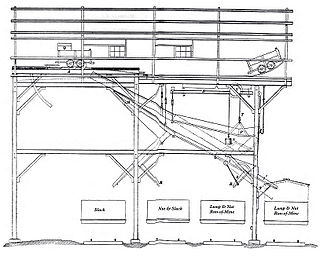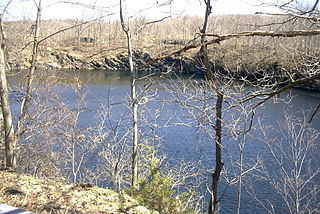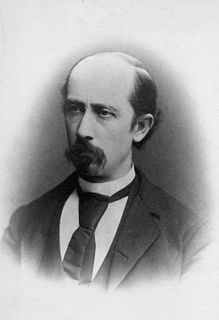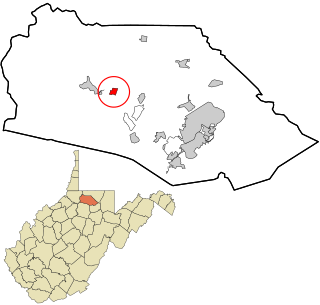
Wilkes-Barre is a city in the U.S. state of Pennsylvania and the county seat of Luzerne County. Located at the center of the Wyoming Valley, it had a population of 44,328 in the 2020 census. It is the second-largest city of the Scranton–Wilkes-Barre–Hazleton, PA Metropolitan Statistical Area, which had a population of 563,631 as of the 2010 Census and is the fourth-largest metropolitan area in Pennsylvania. Wilkes-Barre and the surrounding Wyoming Valley are framed by the Pocono Mountains to the east, the Endless Mountains to the north and west, and the Lehigh Valley to the south. The Susquehanna River flows through the center of the valley and defines the northwestern border of the city.

Luzerne County is a county in the Commonwealth of Pennsylvania. According to the U.S. Census Bureau, the county has a total area of 906 square miles (2,350 km2), of which 890 square miles (2,300 km2) is land and 16 square miles (41 km2) is water. It is Northeastern Pennsylvania's second-largest county by total area. As of the 2020 census, the population was 325,594, making it the most populous county in the northeastern part of the state. The county seat and largest city is Wilkes-Barre. Other populous communities include Hazleton, Kingston, Nanticoke, and Pittston. Luzerne County is included in the Scranton–Wilkes-Barre–Hazleton Metropolitan Statistical Area, which has a total population of 555,426.

Scranton is a city in the U.S. state of Pennsylvania. It is the county seat and largest city of Lackawanna County in Northeastern Pennsylvania's Wyoming Valley. With a population of 76,328 as of the 2020 United States Census, Scranton is the largest city in northeastern Pennsylvania and the Scranton–Wilkes-Barre–Hazleton Metropolitan Statistical Area, which has a population of about 570,000, and the sixth largest city in Pennsylvania after Philadelphia, Pittsburgh, Allentown, Reading, and Erie.

A tipple is a structure used at a mine to load the extracted product for transport, typically into railroad hopper cars. In the United States, tipples have been frequently associated with coal mines, but they have also been used for hard rock mining.

Northeastern Pennsylvania (NEPA) is a geographic region of the U.S. state of Pennsylvania that includes the Pocono Mountains, the Endless Mountains, and the industrial cities of Scranton, Wilkes-Barre, Pittston, Hazleton, Nanticoke, and Carbondale. A portion of this region constitutes a part of the New York City metropolitan area.

The Tilly Foster Mine was an iron mine in the Town of Southeast in Putnam County, New York, USA, two miles west of the village of Brewster along Route 6.

Wehrum is an abandoned coal mining company town in Buffington Township, Indiana County, Pennsylvania that thrived for a time during the early 20th Century. The mine upon which it was entirely dependent closed in 1929, and the last known inhabitants left in 1934. Essentially all that remains of Wehrum today are shadowy remnants of some of the streets and various building foundations hidden in the woods. Wehrum is now one of the ghost towns included in Pennsylvania's Ghost Town Trail.

William Henry Stanton was an attorney, editor, politician and judge. He served as a Democratic member of the U.S. House of Representatives from Pennsylvania's 12th congressional district, elected to fill the vacancy when Winthrop Welles Ketcham resigned and serving for three months from December 1876 to early March 1877. He was previously editor of the Scranton Daily Times until 1872.
Penn Foster College is a private, for-profit online college headquartered in Scottsdale, Arizona. It was founded in 1890 as International Correspondence Schools and presently offers bachelor's and associate degree programs in 22 certified programs, as well as academic certificates.
Penn Foster High School is a U.S. for-profit high school for distance learning. It was founded in 1890 as the International Correspondence Schools (ICS) Penn Foster High School is the largest high school in the United States with over 60,000 students currently enrolled across all 50 states. Programs are self-paced. The school is regionally and nationally accredited. It is headquartered in Scranton, Pennsylvania. It offers a high school diploma program and several high school concentration programs including an early college program for students looking to get a head start on their college education and vocational concentrations in carpentry, plumbing, electrical, health care, or information technology.

Russia iron or Russian iron refers to a type of sheet iron produced in Russia during the 19th and early 20th century. This iron sheeting had a smooth, glossy black surface coating, sometimes greenish-tinged, which did not flake upon bending and made the sheets highly resistant to rusting. As well as its corrosion resistance, the finish would also withstand high heat; these two properties accounted for most of its uses. Kodak used it around 1906 for the manufacture of their Photographic Enlargers. These properties led to it being the standard for manufacturing gold pans at the turn of the 20th century.
Penn Foster Career School is a U.S. for-profit, regionally and nationally-accredited distance education school offering career diploma programs and certificate programs. It was founded in 1890 as International Correspondence Schools, or ICS. Penn Foster is headquartered in Scranton, Pennsylvania.

ICS Learn, also known as International Correspondence Schools Ltd, is a provider of online learning courses in the UK. It was founded in 1889 in Scranton, Pennsylvania. The UK branch was set up in 1904, and it now serves around 25,000 current students. Its students are based in more than 100 countries, predominantly in the UK but also across the Middle East, Asia, and Ireland.

Rachel is a census-designated place (CDP) in Marion County, West Virginia, United States. It is located along Buffalo Creek, 2 miles (3.2 km) east-southeast of Mannington. Rachel has a post office with ZIP code 26587. As of the 2010 census, its population was 248. Rachel is located on U.S. 250 between Farmington and Mannington.

The Avondale Mine disaster was a massive fire at the Avondale Colliery near Plymouth, Pennsylvania, on September 6, 1869. It caused the death of 110 workers. It started when the wooden lining of the mine shaft caught fire and ignited the coal breaker built directly overhead. The shaft was the only entrance and exit to the mine, and the fire trapped and suffocated 108 of the workers. It was the greatest mine disaster to that point in American history.

People have worked as 'coal miners for centuries, but they became increasingly important during the Industrial revolution when coal was burnt on a large scale to fuel stationery and locomotive engines and heat buildings. Owing to coal's strategic role as a primary fuel, coal miners have figured strongly in labor and political movements since that time. After the late 19th century coal miners in many countries were a frequent presence in industrial disputes with both the management and government. Coal miners' politics, while complex, have occasionally been radical, with a frequent leaning towards far-left political views. A number of far-left political movements have had the support of both coal miners themselves and their trade unions, particularly in Great Britain. In France, on the other hand, coal miners have been much more conservative. In India, Coal Miners Day is celebrated on May 4.

Eckley Brinton Coxe was an American mining engineer, coal baron, state senator and philanthropist from Pennsylvania. He was a co-founder of the Coxe Brothers and Company coal mining operation which became the largest individual producer of anthracite coal in the United States at the time.

Gwilym Gwent, was a Welsh-born composer who immigrated in mid-life to the United States.

The Scranton general strike was a widespread work stoppage in 1877 by workers in Scranton, Pennsylvania, which took place as part of the Great Railroad Strike, and was the last in a number of violent outbreaks across Pennsylvania. The strike began on July 23 when railroad workers walked off the job in protest of recent wage cuts, and within three days it grew to include perhaps thousands of workers from a variety of industries.

William Walker Scranton was an American businessman based in Scranton, Pennsylvania. He became president and manager of the Lackawanna Iron and Coal Company after his father's death in 1872. The company had been founded by his father's cousin George W. Scranton. Among his innovations, Scranton adopted the Bessemer process for his operations in 1876, greatly increasing production of steel ties with a new mill. Scranton founded the Scranton Steel Company, in 1891 consolidated as Lackawanna Iron and Steel Company. The steel company became the second largest in the nation. He later also managed the Scranton Gas and Water Company, developing a secure water supply outside the city by creating Lake Scranton.
















